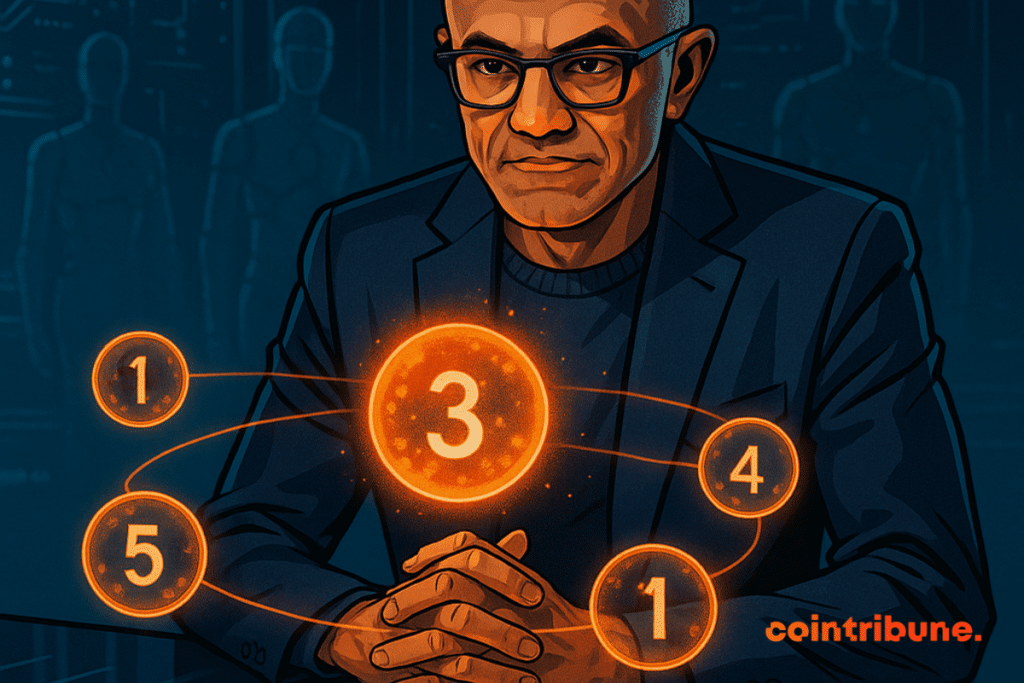Microsoft CEO Reveals the 5 GPT-5 Prompts Powering His Daily Workflow
Artificial intelligence is no longer an option for leaders; it has become an extension of their executive brain. While many employees fear that AI will eliminate their jobs, CEOs use it as a strategic lever to stay competitive. Satya Nadella, head of Microsoft, recently revealed the five GPT-5 prompts he inserts daily into Copilot to boost his work. Concrete evidence that, even at the top, AI is not a gadget, but a survival tool.

In brief
- Satya Nadella, Microsoft CEO, uses 5 GPT-5 prompts daily to organize his work and increase efficiency.
- Other leaders like Jensen Huang and Sam Altman also rely on AI to learn, decide, and manage their daily tasks.
- The art of prompting becomes a key skill, turning AI into a strategic partner for productivity and leadership.
Nadella’s Secret: Prompts That Structure His Daily Life
Satya Nadella does not hide it: he lives with GPT-5 as others live with their agendas, even if OpenAI’s new AI model is not unanimously accepted. Satya Nadella’s prompts are not just technical shortcuts: they constitute a real working method. They serve to summarize his meetings, transform raw exchanges into usable summaries, and immediately highlight priorities. This discipline allows him to eliminate informational noise to focus his energy on what creates the most value.
Here are the 5 prompts he uses daily:
- Anticipate the priorities of a meeting:
“Based on my previous interactions with [person], give me 5 topics that will likely be at the center of our next meeting.” - Generate a clear progress report:
“Write a project update from the emails, discussions, and meetings of series [X]: compare KPIs to objectives, list successes/failures, identify risks, competitor movements, and propose possible difficult questions with their answers.” - Assess the probability of success of a launch:
“Are we on track for the launch of [Product] in November? Check the technical progress, pilot program results, and risks. Give me a probability of success.” - Audit the use of his time:
“Analyze my agenda and emails from the last month and create 5 to 7 project categories on which I spent the most time, with the percentage of time invested and a brief description.” - Prepare efficiently for a meeting:
“Analyze [this selected email] and prepare me for the next meeting of series [X], based on past discussions of the manager and the team.”
One of his favorite prompts is to transform fragmented notes into a clear and motivating dashboard for his team. Another, equally powerful, breaks down complex projects into operational checklists, making critical steps immediately visible.
This systematic use of AI is not a fad. It illustrates a profound shift: the modern leader is no longer just a decision-maker but an architect of the cognitive flows of his organization — and AI is now the cement.
Other Leaders Also Use AI
Nadella is not an isolated case. Jensen Huang, head of Nvidia, admitted using ChatGPT and Perplexity as a personal “tutor.” He asks AI to explain complex topics like to a child and then increase complexity to the university level. A way of learning that perfectly illustrates the cognitive flexibility these tools offer.
Sam Altman, CEO of OpenAI, admits he still juggles between paper and AI, but uses ChatGPT daily to filter his emails and compress his readings. He goes even further: AI helped him understand his role as a young father, breaking down often confusing parental information into simple recommendations.
This massive adoption by technological elites shapes a near future: AI will no longer be a secondary tool but the invisible framework of decision-making in all sectors.
How to Make Good Prompts
While models like GPT-5 are increasingly powerful, the art of prompting remains decisive. Anthropic, the company behind Claude, emphasizes the “golden rule of clarity”: if your prompt confuses a human colleague, it will also confuse AI. Simplicity, order, and precision remain the best allies.
It is also crucial to dare to correct artificial intelligence. Many add “think step by step” in their instructions but do not check if the machine really follows this logic. As in any conversation, you need to adjust, reformulate, and challenge the interlocutor, even when it is an AI model.
While AI tries to steal the spotlight from artists, at the same time, it can become a communication coach. As Maggie Vo from Anthropic points out: the more you dialogue with it, the more you learn to give clear instructions. It is a virtuous circle where each interaction sharpens your ability to think and lead.
Maximize your Cointribune experience with our "Read to Earn" program! For every article you read, earn points and access exclusive rewards. Sign up now and start earning benefits.

Fascinated by Bitcoin since 2017, Evariste has continuously researched the subject. While his initial interest was in trading, he now actively seeks to understand all advances centered on cryptocurrencies. As an editor, he strives to consistently deliver high-quality work that reflects the state of the sector as a whole.
The views, thoughts, and opinions expressed in this article belong solely to the author, and should not be taken as investment advice. Do your own research before taking any investment decisions.